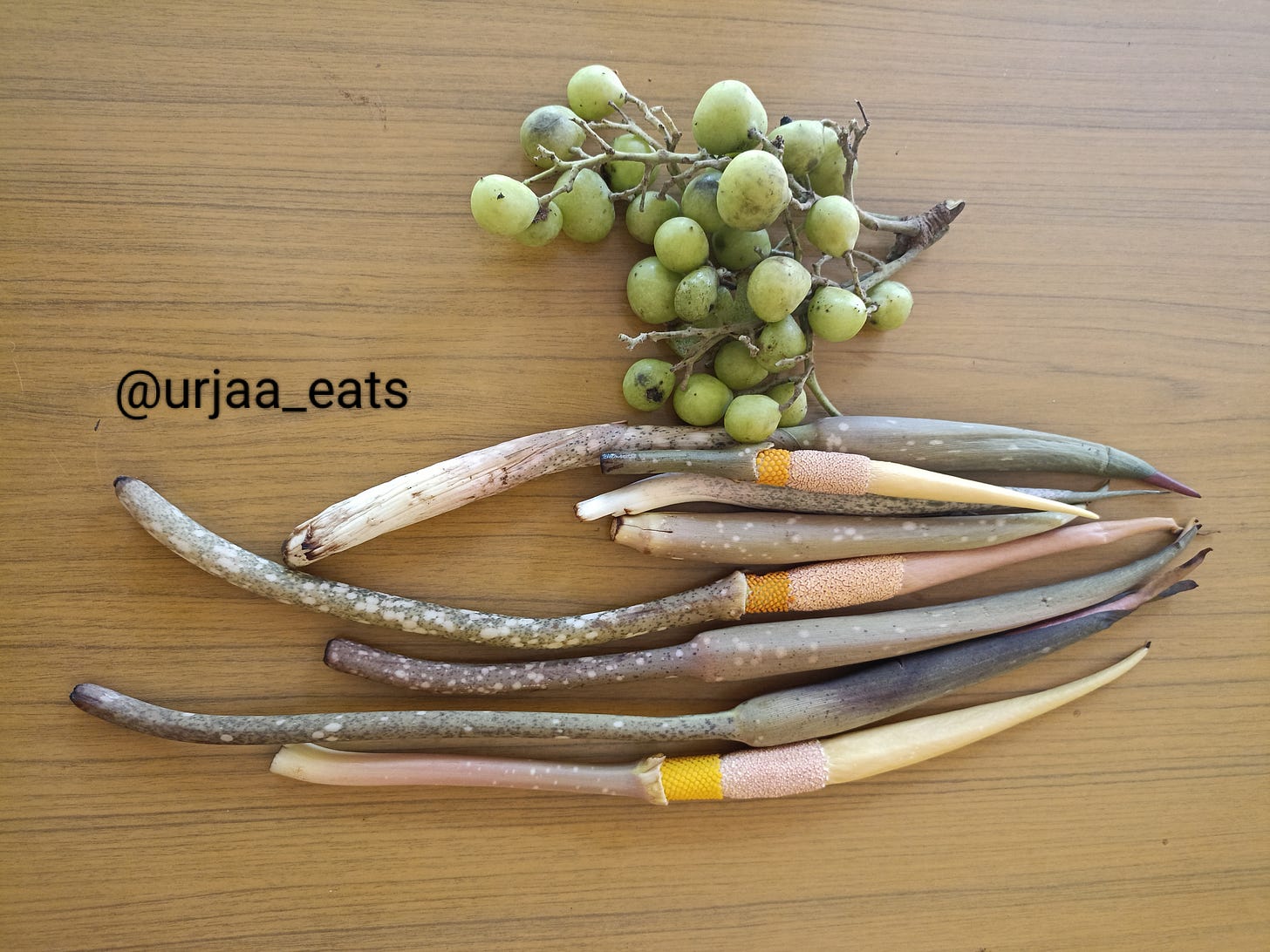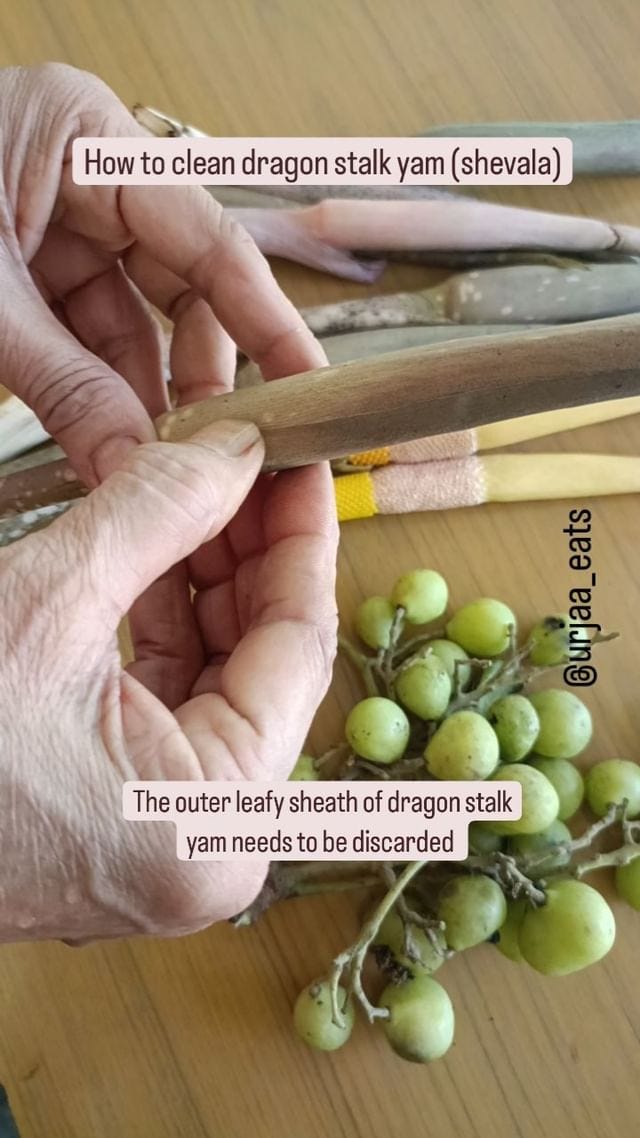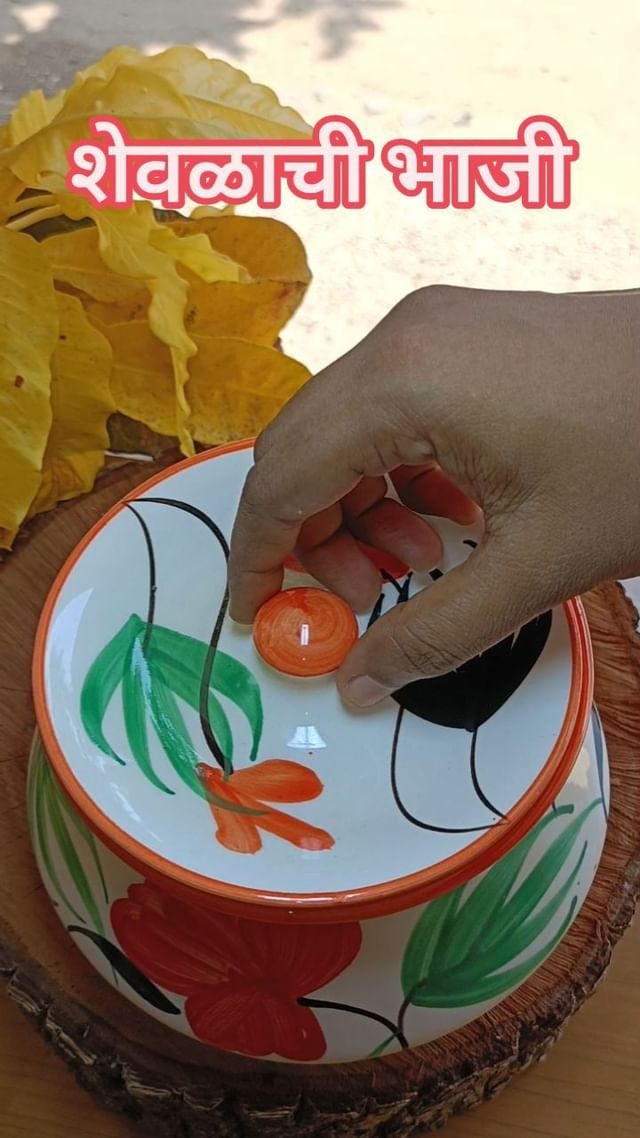Everything you should know about monsoon’s foraged vegetable of Maharashtra : Dragon stalk yam (shevala).
The first few rains bring with them an array of fascinating forest greens (raan bhaji’s) that are in season for a limited period of time. Dragon Stalk Yam is one such forest green (raan bhaji) that is uncultivated vegetable which is found in hills and forests following first rain or sometimes even before it rains .It grows in the forest and hilly areas of Palghar, Thane, and Raigad districts in Maharashtra during monsoon season. Available only for about 20-25 days during start of monsoon.
Scientific name: Amorphophallus commutatus
English: Dragon stalk yam
Marathi: shevala , mogari kanda
Gujrati: jungali suran, mogari kanda
Konkani : Vajramuth
Ever since I was a toddler not a single monsoon has passed without seeing my mother prepare shevalachi bhaji. This one is popular for its robust, meaty taste. The communities that prepare shevala include the Pathare Prabhu’s, Somavanshi kshatriya pathare, Chandraseniya Kayastha Prabhu (CKP) ,Panchkalshi, Aagri’s and Saraswat Brahmin. It is mainly used by Communities along the North konkan Coast.
Dragon stalk yam is a ephemeral plant, ephemeral plants are the one’s with short life cycle. Originally discovered and widely consumed by tribal community, which is still vital to tribal community’s culinary traditions. As the monsoon season arrives, the diet of the native tribal community primarily consists of these raan bhajis (Forest greens) that are foraged during the monsoon season. They gather them in the monsoon season to provide them with sustenance and nutrition. You can only find this raan bhaji by foraging them and this one is truly a seasonal must-have .I am fortunate enough to get my hands on some indigenous pre-monsoon wild vegetables each year. All you have to do is to browse through the subzi markets in your area. Monsoon has to offer a variety of wild edible greens and vegetables .A few of them are available only for a brief period in Mumbai, where they are sold by some vendors. Which they mainly source from palghar, raigad and thane district. Some of those are also foraged from SGNP, aarey and surrounding forest areas.
Because shevala has an irritating substance, it is always provided and prepared with kakad, a fruit that resembles amla (gooseberry) and takes away the itching. Kokum and tamarind, two souring agents, balance the flavors. You can prepare a curry (Aamti) with it by adding field beans (vaal). Non-vegetarians make it with prawns or kheema, which is cooked minced goat meat.
WHERE TO FIND SHEVALA IN & AROUND MUMBAI?
Finding shevala in Mumbai is a struggle in itself sometimes. The local vegetable vendor will never sells it because of the fact that it is often only accessible from mid-June to early july. These kinds of wild delicacies are transported to metropolitan markets from Palghar and Vasai by women who are well-known for selling local items. Shevala is available in the markets of Virar, Vasai, Borivali, and Dadar (Specifically near markets near railway stations) during the first two to three weeks of June.
WHAT IS THE APPEARANCE LIKE:
The stalk features hollow spadix ( pod ) that is a mixture of maroon, pale yellow, or green when the outer leafy sheath is peeled off.
HOW TO CLEAN AND PREPARE:
When preparing dragon stalk yam, wear gloves since the calcium oxalates in the vegetable might cause itching. You can put kokum or lemon juice on your hands as citric acid helps offset the oxalates. With your hands, remove the outer leafy sheath and trim and discard the lower part of the stalk, located slightly below the bright yellow band that is ribbed. In some communities the yellow bright band is also discarded.The easiest way to enjoy the meaty feel of the tuber is to slice it into rounds. Crush the kakda using Mortar and Pestle, deseed and discard seeds so that you can use the rest of fruit to add in the curry.Locals in and around Mumbai like use dragon stalk yam with kakada (Garuga pinnata), a sour fruit that resembles gooseberries. Additionally, tamarind efficiently neutralizes oxalates. Its slightly rancid scent can be covered up with aromatic spices, curry leaves, fresh coconut, and kokum.
Here’s a detailed video of cleaning dragon stalk yam (shevala)
HOW DOES IT TASTE:
The closest way to describe the flavor is as really meaty and mushroom-like. It's just one of those tastes you pick up when you start consuming certain items while you're young! It has an earthy, umami flavor. It has a firm, slightly chewy texture that is reminiscent of fibrous banana flower. The ones you get right before first rains are supposed to taste better compared to the ones you get after.
HOW TO STORE THEM:
These can be frozen by deep-frying them in oil until they are crisp and then storing them in an airtight container for a year in deep freezer.
Here’s the recipe of (dragon stalk yam curry ) Shevala chi bhaji :
References :
https://roundglassliving.com/food/ingredients/dragon-stalk-yam
https://lovethewild.wordpress.com/tag/dragon-stalk-yam/
https://garden.org/plants/view/455333/Voodoo-Plant-Amorphophallus-commutatus/




